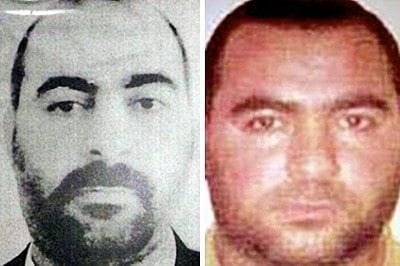What is ISIS?
The Islamic State in Iraq and Syria is an unrecognized state and active Jihadist militant group in Iraq and Syria. In its unrecognized self-proclaimed status as an independent state, it claims the territory of Iraq and Syria, with implied future claims intended over more of the Levant including Lebanon, Israel, Jordan, Cyprus and Southern Turkey. They are also known by two other names: Islamic State of Iraq and the Levant and Islamic State in Iraq and al-Sham.
What is the Levant?
Levant consists of the island of Cyprus, Israel, Jordan, Lebanon,Syria, Palestine, and part of southern Turkey
The Modern History of the Levant
In 1514 Selim the Grim began the systematic Ottoman conquest of the region. Syria was occupied in 1516 and Egypt in 1517, extinguishing the Mameluk line. Iraq was conquered almost in 40 years from Safavids, were successors of Aq Qoyunlu. The Ottomans united the whole region under one ruler for the first time since the reign of the Abbasid caliphs of the 10th century, and they kept control of it for 400 years.
“The Ottoman Empires was one of the greatest, most extensive, and long lasting in the History of the World. It included most of the territories of the Eastern Roman Empire(…) and held portions that the Byzantines never ruled (…) The Ottoman Empire was born in 1300 and endured until World War I-.”
Sykes-Picot Agreement
The Sykes–Picot Agreement, officially known as the Asia Minor Agreement, was a secret agreement between the governments of the United Kingdom and France, with the assent of Russia, defining their proposed spheres of influence and control in the Middle East should they succeed in defeating the Ottoman Empire during World War I.
The negotiation of the treaty occurred between November 1915 and March 1916. The agreement was concluded on 16 May 1916.
The agreement effectively divided the Arab provinces of the Ottoman Empire outside the Arabian peninsula into areas of future British and French control or influence. The terms were negotiated by the French diplomat François Georges-Picot and British Sir Mark Sykes.
The agreement is seen by many as a turning point in Western–Arab relations. It did negate the promises made to Arabs through Colonel T. E. Lawrence for a national Arab homeland in the area of Greater Syria, in exchange for their siding with British forces against the Ottoman Empire.
Almost 100 years later (2014), the jihadist organization ISIS uses Sykes-Picot as their rallying cry and have conquered Mosul and parts of northern Syria to form an Arab Caliphate along sectarian lines rather than definitions of European diplomats.
How did ISIS form?
ISIS was formed in April 2013 and grew out of al-Qaeda in Iraq (AQI). It has since been disavowed by al-Qaeda, but become one of the main jihadist groups fighting government forces in Syria, with the Al Nusra Front and Free Syrian Army, and is making military gains in Iraq.
The organisation is led by Abu Bakr al-Baghdadi. Little is known about him, but it is believed he was born in Samarra, north of Baghdad, in 1971 and joined the insurgency that erupted in Iraq soon after the 2003 US-led invasion.
Who is their leader Abu Bakr al-Baghdadi?
He was held at a US detention camp, Camp Bucca, in Iraq after the invasion.
A twitter account (@wikibaghdady) has leaked biographical details that followed fit with the available record and have been confirmed by subsequent reports on Baghdadi—that his real name is Ibrahim Awwad Ibrahim Bou Badri bin Armoush, and he was born not in Baghdad but Samarra.
He has a PhD in Islamic studies from the Islamic University of Baghdad.
What is ISIS trying to accomplish?
They are trying to reestablish a Caliphate.

This is a graphical representation of the territory ISIS is trying to control.
Why are they having so much success?
1) Money
- ISIS received a huge injection of cash when it captured the northern Iraqi city of Mosul, reports say. During the invasion, ISIS reportedly secured more than $466 million and a large quantity of gold bullion when it broke into Mosul’s central bank. Since then, the organization has continued to loot and pillage everything in its path, adding to its already considerable wealth. ISIS has also become increasingly well-armed as it appropriates military weapons and equipment left behind after the United States pulled out of Iraq in 2009. (Source)
- Oil fields in Iraq and Syria
- Roadblocks with forced “donations”
- Extortion of businesses in Iraq and Syria
- Wealthy Gulf donors/quasi state actors
- Deviation of funds from charities, as many support Syria charities are rather dubious entities..
- Tariffs at the border-crossings they control
2) Weapons from seizing cities Many of these weapons were sold to the government and originate from the United States 

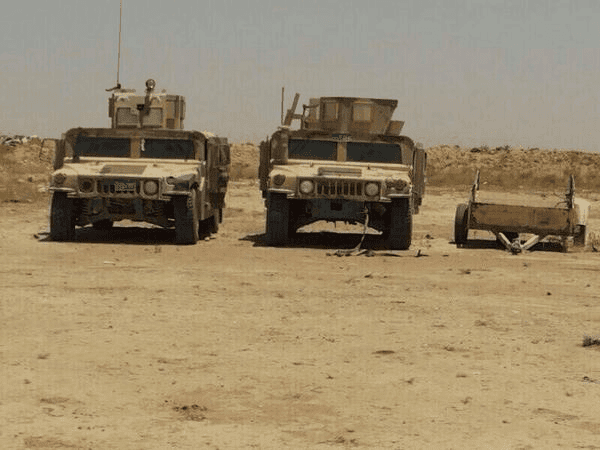


4) Saddam Hussein’s former General Izzat Ibrahim al-Douri
“The most significant charge @wikibaghdady made—and the one that now seems most prophetic, after the group took control of Mosul, Iraq’s second-biggest city—is that ISIS’s inner chamber of power, hidden by Baghdadi’s public front, is led by a former Baathist and colonel in Saddam’s army called Haji Bakr.
According to @wikibaghdady, it was Bakr who engineered Baghdadi’s rise to power after ISIS’s former leader, Abu Omar al-Baghdadi, was killed in 2010 by a joint U.S.-Iraqi operation in Tikrit. That Baathist connection resurfaced last week after ISIS’ Iraq offensive and has proven to be a critical aspect of the group’s strategy and a cornerstone of its current ability to take and hold ground.
Last week, on June 13, the @wikibaghdadi account claimed a “Meeting between ISIS and Naqshbandi Army near al-Qayara area south of Mosul had taken place with representatives from Izzat Ibrahim al-Douri and Baghdadi.”
Izzat Ibrahim al-Douri is a mythic figure among many of Iraq’s Sunnis. A high-ranking commander in the Iraqi army before the American invasion, al-Douri became the leader of Iraq’s banned Baath party after Hussein was executed in 2007.
He managed to evade capture by American and Iraqi forces and has been in hiding pretty much since then. Since his disappearance, sightings of al-Douri have been reported in Mosul but he has never resurfaced publicly. Now, al-Douri appears to have resurfaced leading the The Naqshbandi Army, the former Baathist officers who form a cornerstone of the Sunni coalition in Mosul that includes ISIS.
After al-Douri’s hiding out for years in Mosul, cultivating the underground Sunni insurgent force, reports about al-Douri suddenly started popping up in the last week. Despite the rhetoric about the ISIS takeover of Iraq, it’s clear that the group’s rapid advance owed much to its alliance with other Sunni groups, including the Baathist Naqshbandis led by al-Douri.” (Source)
5) The Shia-Sunni split: “There is definitely an emerging struggle between Sunni and Shia to define not only the pattern of local politics, but also the relationship between the Islamic world and the West,”-Daniel Brumberg of Georgetown University, author of Reinventing Khomeini: The Struggle for Reform in Iran.
The original split between Sunnis and Shiites occurred soon after the death of the Prophet Muhammad, in the year 632. There was a dispute in the community of Muslims in present-day Saudi Arabia over the question of succession. Who was the rightful successor to Muhammad?
Most of the Prophet Muhammad’s followers wanted the community of Muslims to determine who would succeed him. A smaller group thought that someone from his family should take up his mantle. They favored Ali, who was married to Muhammad’s daughter, Fatimah.
Shia believed that leadership should stay within the family of the prophet. They were the followers of Ali, his cousin and son-in-law.
Sunnis believed that leadership should fall to the person who was deemed by the elite of the community to be best able to lead the community.
The Sunnis prevailed and chose a successor to be the first caliph. Eventually, Ali was chosen as the fourth caliph, but not before violent conflict broke out. Two of the earliest caliphs were murdered. War erupted when Ali became caliph, and he too was killed in fighting in the year 661 near the town of Kufa, now in present-day Iraq.
The violence and war split the small community of Muslims into two branches that would never reunite. The war continued with Ali’s son, Hussein, leading the Shiites. “Hussein rejected the rule of the caliph at the time,” says Vali Nasr, author of The Shia Revival. “He stood up to the caliph’s very large army on the battlefield. He and 72 members of his family and companions fought against a very large Arab army of the caliph. They were all massacred.”
Hussein was decapitated and his head carried in tribute to the Sunni caliph in Damascus. His body was left on the battlefield at Karbala. Later it was buried there.
If Isis succeeds in reaching the Shia holy cities of Karbala and Najaf. Isis has vowed to destroy the Shia shrines in those cities and threatens a genocidal campaign against all Shias. Such a move could inspire Sunni militants to attack Shias everywhere, while forcing Shia militants to take revenge on Sunnis across the globe.
There is little the vast majority of peaceful Muslims around the world would be able to do. An audio statement by Abu Mohammed al-Adnani of Isis last weekend is a call for the mass killing of Shias:
“We need to settle our differences with you,” his statement read. “These differences go back a long way. We will settle our differences not in Samarra or Baghdad but in Karbala, the filth-ridden city and in Najaf, the city of polytheism.”

Sunni emphasis in Iraq
Sunni Arabs seems themselves as a marginalized minority unfairly targeted and uninvolved in the political process. ISIS has branded itself as the Sunni savior in Iraq. The Sunni people are even welcoming them in many areas of Iraq currently:
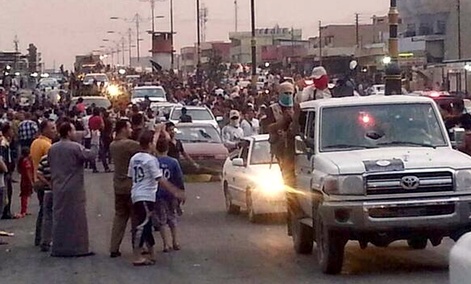
Iraqi government atrocities
“The failure of Iraqi leaders, including Prime Minister Nouri al-Maliki, to build an inclusive political system has enabled the current startling advances of militants across Iraq led by the Islamic State of Iraq and al-Sham, or ISIS.” (Source)
Five killed, 23 wounded as Iraqi army opens fire on anti-govt protest Iraqi Prime Minister Killing Sunnis To Get Shiite Votes
Sunni Civilians Run Over By Iraqi Army Vehicle (Warning Graphic)
Some Sunni Prisoners executed by the Iraqi Army (Warning Graphic)
What would life under an ISIS Caliphate look like?
Yesterday a member of ISIS (@AbuBakrAl_Janab) took the time to let me interview him via twitter. Here is our conversation: 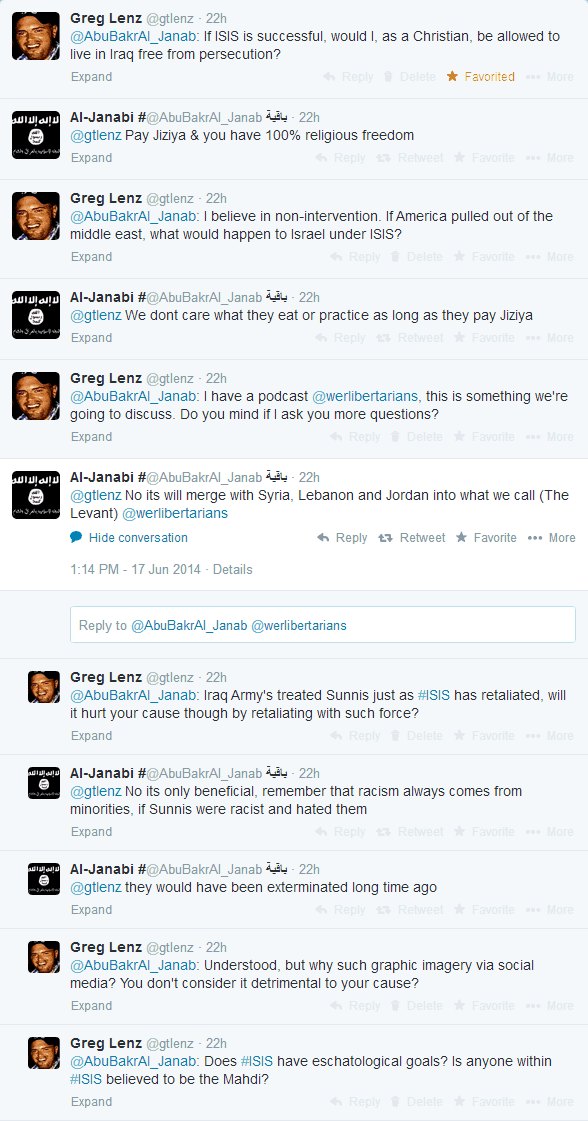

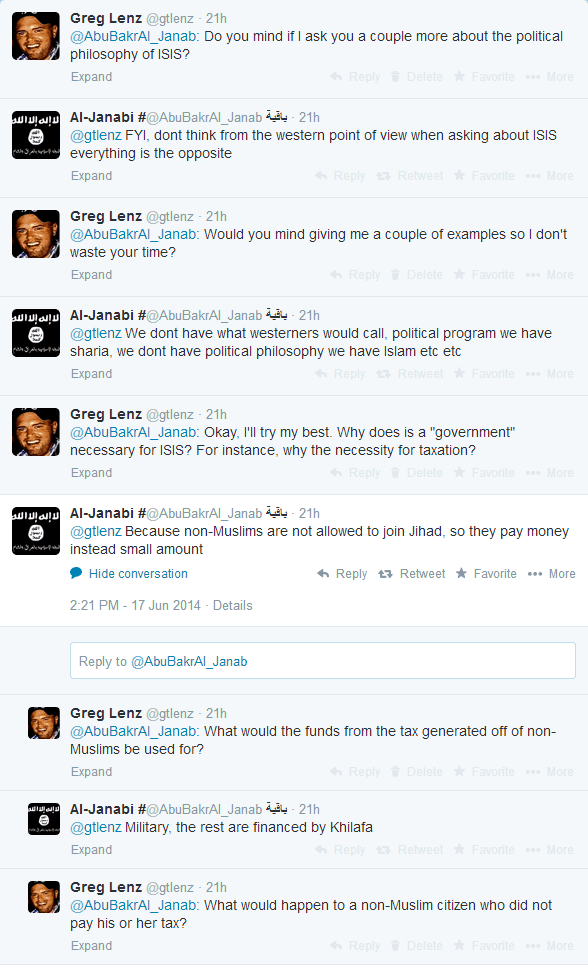
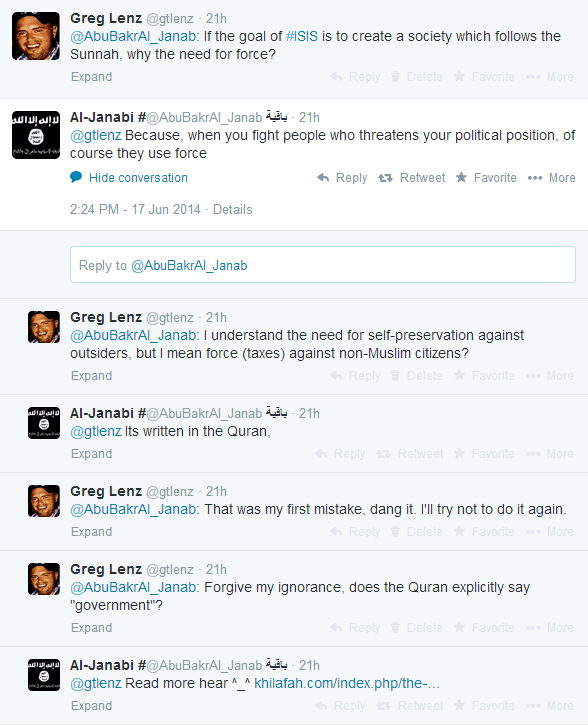
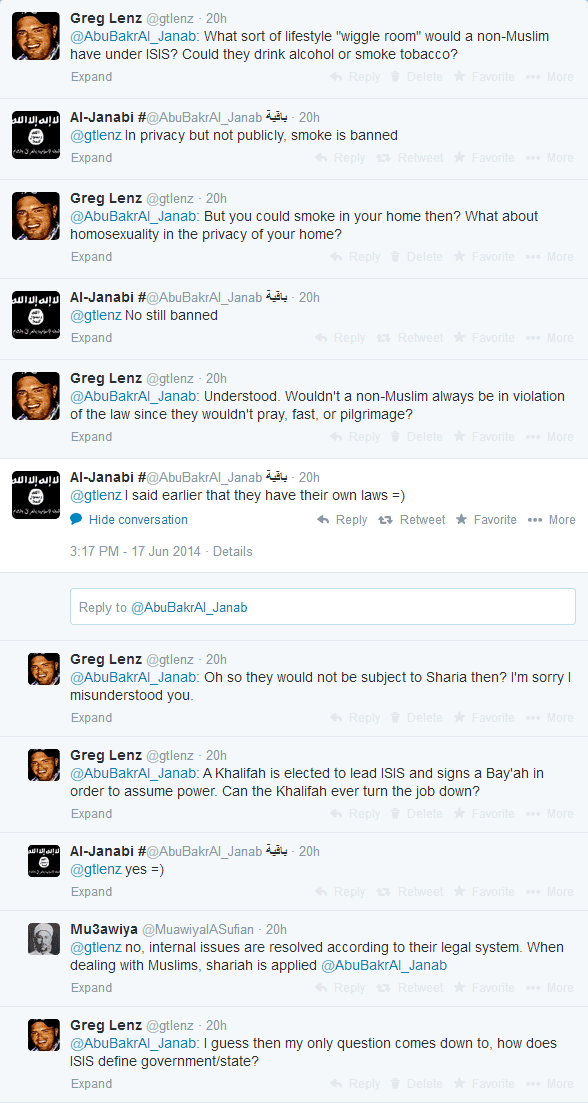
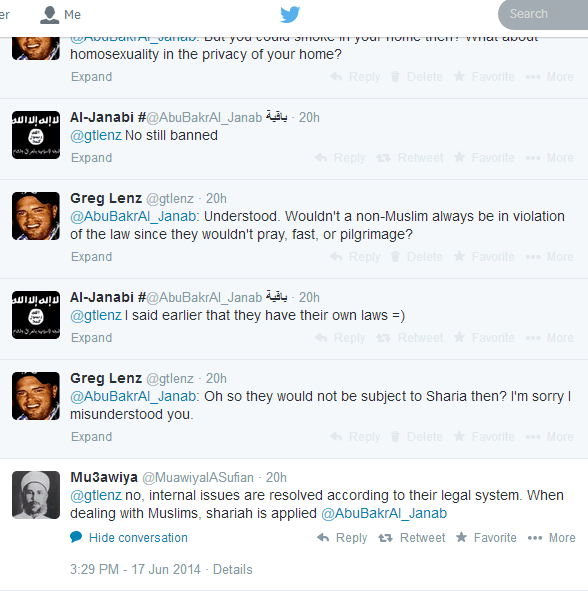
Response from a different ISIS member (@AbuRashashISIS)
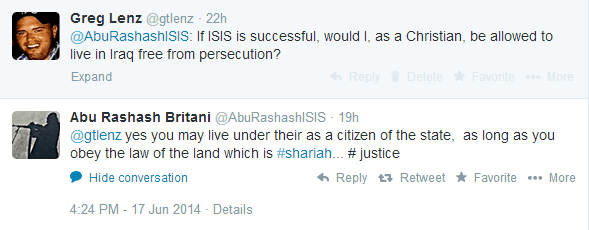 As you can see there are some different schools of thought regarding the application of Sharia law to non-Muslims. Everyone stopped the conversation when I asked them to define government. I have messaged each of them several more times today asking them to either define government or explain its necessity for the creation of the ISIS Caliphate.
As you can see there are some different schools of thought regarding the application of Sharia law to non-Muslims. Everyone stopped the conversation when I asked them to define government. I have messaged each of them several more times today asking them to either define government or explain its necessity for the creation of the ISIS Caliphate.
I’ve yet to get a response…
The Caliphate governing structure would be comprised of 4 parts:
1) Caliph (Khaleefah): is the head of state in the Khilafah. He is not a king or dictator but an elected leader whose authority to rule must be given willingly by the Muslims through a special ruling contact called baya. Without this baya he cannot be the head of state.
This is completely opposite to a king or dictator who imposes his authority through coercion and force. The tyrant kings and dictators in the Muslim world are ample examples of this, imprisoning and torturing the Muslims and stealing their wealth and resources.
This contract of baya stipulates that the Khaleefah must be just and rule the people by sharia. He is not sovereign and cannot legislate laws from his own mind that suit his personal and family interests. Any legislation he wishes to pass must be derived from the Islamic legal sources through a precise and detailed methodology called ijtihad.
2) Unjust Acts Court: If the Khaleefah legislates any law contrary to this or commits oppression against his people the court can impeach the Khaleefah and order his removal from office.
3) Enforcement Agency: This agency would be responsible for carrying out the penalties issued by the court.
4) Military
Why does ISIS believe a new Caliphate is necessary?
From the Qur’an: Allah (SWT) says in the translation of the meaning of the Qur’an ul-Kareem (TMQ):
1. “But no, by your Lord, they will not have Eeman until they make you (O Prophet) rule between them in that wich they dispute, and they find in their souls no resistance against your decisions, but accept them with the fullest conviction” (TMQ 4:65).
2. “Indeed, we have revealed to you the book with the truth so that you may rule between mankind by that which Allah has shown you”(TMQ 4:105).
3. “So rule between them by that which Allah has revealed, and follow not their desires, but beware of them in case they seduce you from just some part of that which Allah has revealed to you” (TMQ 4:49).
4. “Whosoever does not rule by that which Allah has revealed, they are disbelievers (Kafiroon)…..the thaalimoon (oppressors)….the fasiqoon (evil doers)” (TMQ 4. 5:44-47)
These ayaat (verses) of Qur’an, and many others, prove beyond doubt the obligation of ruling by what Allah has revealed. The first one in particular refers to the Muslims directly by stating that we have no real Imaan (belief) until we make them judge between us by Allah’s revelation. This is an indication of the obligation for all Muslims to establish Allah’s ruling system. (Source)
How does ISIS justify the gruesome manner in which they act?
ISIS feels that Sunnis have been victimized in Iraq. Their families and religious brothers have been killed. They view each act as retribution in accordance with Sharia law.
In addition, the gruesome images below are used as evidence of their success to recruit new members:

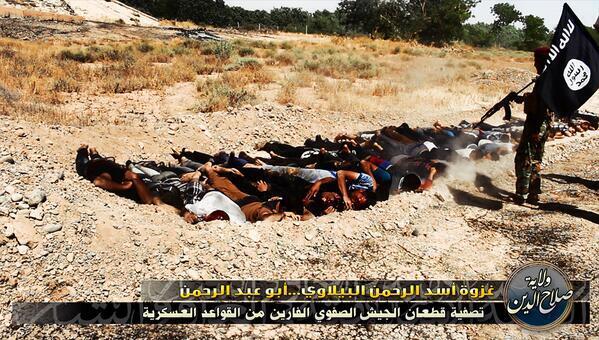
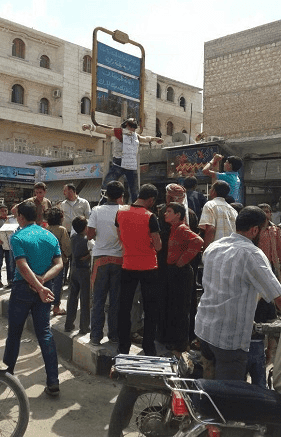
So, the question that remains is what is the proper libertarian response to ISIS?
The libertarian position is one of non-intervention. Therefore, libertarians would say that the situation in Iraq is not of our concern until it directly effects us and threatens our security.
Libertarians can only hope that individuals in Iraq will stand up to tyranny and claim their natural right of self-governance.
However, I am torn. The situation in Iraq exists because of outside intervention from other governments.
Do I, as a libertarian, have any responsibility? No.
Do I as a human being who believes each individual should be able to live in total freedom of tyranny feel responsible?
Of course. But that is not possible in Iraq. Some organization will ultimately end up ruling that land. However, I cannot help but think at a bare minimum I should offer safe harbor to those who wish to flee Iraq.
Intervention at this point will clearly do more harm than good for those who wish to self-govern. As the old saying goes, “The path to hell is paved with good intentions.”
At what point is intervention allowable in Iraq?
Only when an expansionist Caliphate threatens my personal freedoms?
Within the libertarian framework, are preemptive measure explicitly prohibited, even if it is a certainty your freedoms will be threatened in time?
I wish I had the answer because I am still wrestling with these thoughts. I engaged members of ISIS on social media because I felt the best way I could contribute was to engage them in a discussion about the necessity of forming a government in order to implement their vision.
If ISIS gave inhabitants of Iraq the choice of joining their organization and voluntarily submitting to their laws, I would not feel intervention is necessary.
However, I doubt a single ISIS member has given thought, as to whether offering individuals the choice of joining ISIS, would be more in accordance with the values of Islam.
The word “Islam” means “voluntary submission to God”
How can a Caliphate (government) be voluntary? By forcing the inhabitants in Iraq to live under the Caliphate, isn’t ISIS robbing each individual of their ability to voluntarily submit to God?
A Caliphate is contrary to the central tenet of Islam. If an individual has no choice in becoming a citizen of ISIS, how can they voluntarily submit to God’s will? As Frank S. Meyer said,
“Acceptance of the moral authority derived from Transcendent criteria of truth and good must be voluntary if it is to have meaning; if it is coerced by…force…it is meaningless.”
Government caused the horrific atrocities Sunnis have encountered for thousands of years. Does ISIS really believe the solution to the problem caused by government is government?
Muhammad was a community organizer, not a government leader. Sure, he authored the Constitution of Medina, but only so warring tribes, could live together in peace. The Constitution of Medina rights for those who consented and a system of settling disputes.
Did it form a government? Nothing like a Caliphate.
It was a voluntary social contract. Those who chose not to accept the contract were neither subject to it, nor protected by it.
ISIS should follow the example set by Muhammad. Offer individuals living in Iraq the opportunity to voluntarily become a member of the Islamic State of Iraq and al-Sham.
The solution is for ISIS, Shiites, Kurds, and all inhabitants of Iraq to commit to a ceasefire and call a constitutional convention. Collectively draft an Iraqi Constitution like the one Muhammad drafted in Medina so long ago. Do it with the his same sentiment, to find a way to live together in harmony.

